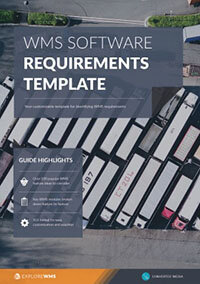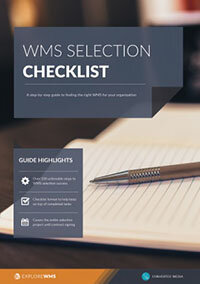Here's your complete WMS modules and features checklist
Every WMS requirement is unique, but that doesn’t mean they’re all very different. Most tend to follow the same set of requirements and needs, addressing common problems and desires. The important thing for you to decide is where you’ll be a standard user and where you need additional support.
For example, if you’re running a specific type of robotics for picking, you need a WMS that can work with that platform and properly support the lines and methods it uses.
Nuance and the specific way you structure your operations should be considered as you build out your set of “must-have” warehouse management system modules. It’s also a smart idea to collect lists of things you would want to have in the near term and features you would like to have four or five years down the road.
So, we’ve compiled a large checklist to help you get started. Choose what works for you, add any requirements you have, and then start speaking to vendors directly and using comparison tools to build your shortlist.
Receiving
Receiving is the heart of your warehouse. When things go wrong here, the harm ripples through the rest of your operations. Here are the must-have functions and modules to keep you running smoothly.
- Receiving of orders
- Multiple types of receipt orders
- Specialty receipt support
- Allow/restrict partial case receipts
- Reverse and voiding of receipts
- Appointment scheduling
- Dock scheduling
- Cross-docking
- Yard management
- Directed put-away
- Returns management
- Vendor data tracking
- Label verification
- Label generation
- Palletize LPNs on receipt
- Mobile scanner and app/smartphone support
Inventory management
Know what you have so you can sell it. Inventory-focused warehouse management system modules are designed to ensure you always have accurate inventory counts but also can predict when you’ll need to re-order. While analytics has its own section, you’ll want to start thinking about the metrics around these modules so that you know your most important KPIs and requirements for that functionality.
- Replenishment
- Cycle counting
- Serial tracking
- Lot tracking
- Quality control
- Task interleaving
- Labor management
- Periodic inventory snapshots
- Data tracking across skids, LPNs, packages, and units
- Misc. inventory labeling and tracking support
- Material handling to pick lanes, combinations
- Location-defined SKUs
- Adjustable form fields such as lot #, owner, location
Get more in-depth feature ideas with our WMS requirements template
Order fulfillment and management
Order fulfillment encompasses the most thought of warehouse activities for any business. It’s the entire process from receiving an order to getting it out the door and to the customer. There’s a lot of functionality here and most of it is standard. You’ll want to think about any efforts you take to get a product ready to ship as well, such as kitting and assembly, plus how your orders should be managed. For instance, if you have multiple warehouses, you’ll want smart order routing that sends orders to only the warehouse that has products to fill them right away.
- Purchase orders
- Pick tickets
- Work-in-process materials tracking
- Inventory availability
- Order entry
- Rule-based (smart) order routing
- Rule-based allocation tracking and configuration
- Rule-based restrictions
- Allocation tracking and management on component level
- Kitting
- Assembly
- Parts requirements
- Automated inventory updates
- Order prep
- Scan packing
- Inspection and auditing in kits, batches, cartons
- Consolidation by shipment or order
- Pack and hold support
- Shipping label generation including Skid, LPN, and UCC
- Package and content labels
- Price stickers
- Customized font, size, etc.
- Distributed order management
- Fulfillment tracking and audits
- Customer ship-top information storage and tracking
Advanced picking and shipping
Picking, packing, and shipping needs change as companies grow. These WMS requirements are designed to show you modules to consider as operations scale. While you might not need support for advanced picking methodologies today, selecting a WMS that includes the modules will mean you don’t need to replace the system for future access. Based on how companies are now sorting functionality, our 2020 update has moved transportation management modules, such as automated carrier selection, to this set of modules.
- Wave management
- Picking including Zone, Skip, LPN, Batch
- Picking confirmation by type
- Skid substitution support
- Pack lists
- Invoice creation and management
- Sensor support and compliance (RFID especially)
- Shipment notifications
- Advanced picking options such as voice-enabled support
- Captures asset tags during picking
- On-demand replenishment to static, dynamic lanes
- Two-stage replenishment support
- Carrier selection tools and automation
- Freight rating and calculators
- Order consolidation support
- Bid optimization
- Route optimization
- Freight payment
- Carrier audit tools
Analytics
- Tracking for your preferred KPIs across your warehouse
- Daily performance and labor tracking
- Equipment usage and maintenance schedules
- Warehouse layout optimization
- Lead time understanding
- Return-rate tracking
- Inventory turn tracking
- Ability to review historical data
- Predictive analytics by category and product
- Dashboards that are easy to read
Integrations with standard supply chain tech
The functionality we listed above should be covered by your WMS. But that coverage can be a little tricky and doesn’t necessarily have to be within a specific WMS module.
Reading that now might seem a little confusing, but consider how you work each day.
Let’s look at order entry, for example. It’s possible that you will manually enter orders on occasion, so the WMS should support this. However, you likely get orders from an online e-commerce system or customer portal. The WMS doesn’t need to create either of these solutions for you, it just needs to be able to receive the order data from these locations. You achieve that by integrating it with your e-commerce or customer-facing software.
Getting the right WMS for your business includes finding one that supports your needed integrations.
E-commerce tool integration makes sense for growing businesses and many B2C companies. For the B2B side, one of the more popular solutions today is a WMS that can integrate with TMS tools. This will help you run your warehouse and overall operations, whether or not you’re a shipper. Consider asking partners what they use and what you might be able to support.
Why is this important to shippers? Data shows that using a TMS can reduce freight invoice payments by up to 95%. Even if you are just managing equipment and fleet for local deliveries or moving between your own sites, a TMS can help you better plan for costs and generate savings in fleet management, fuel usage, routes, and even customer/supplier relations.
You want to think about the software you use throughout the year and include as much as possible. Don’t limit yourself just to software that touches directly on your supply chain. There are many industry standards to help run other parts of your business, such as marketing tools, email management, and accounting platforms like QuickBooks.
Tailor the integration requirements to your own business. If you run your own warehouse, for instance, your WMS should be able to report labor trends to your payment system. However, if you’re a 3PL running a fulfillment center for many clients, the WMS’ labor and order metrics should integrate with billing software too — so clients are billed appropriately for the orders you fill and the staff you needed.
Integration and reporting are becoming standard, which is helpful for businesses like yours. The next piece to ask for is a way to automate the process.
Prioritize automatic data sharing
For your WMS to be at its most useful, it needs to collect and share a wide range of information. Cloud solutions are generally promoted because they can save on initial costs. However, they may be smart for your long-term growth, too, if you choose a WMS that supports and has its own APIs.
An API will automate the way software shares information. WMS that support third-party APIs might be able to get information from your ERP or e-commerce tools, while having its own API can make it easy to automatically send re-supply orders to your suppliers.
Think about the data you use currently in your warehouse, not just in the WMS. You’ll have labor information, equipment maintenance, inventory counts, packing materials, order volumes, returns, and much more.
Each data point you use — and every single bit you send to someone else — should be collected. Your WMS will either need to serve as the place that collects all of this information, or it should be able to easily, quickly, and accurately share data with whatever you use as your central hub. APIs are designed to do that within your operations and with your partners’ systems.
Ask any vendor who is on your shortlist to discuss how their WMS can automate your data collection and sharing. If you choose one that can’t do this automatically, you run the risk of errors due to manual tasks and increased costs from partners who want data feeds instead of faxes and phone calls.
Addressing the unique features that you need
If you hired a new warehouse worker who already had experience in a fulfillment center the same size as yours, what would you need to train them on most? What habits would you have to change because your business does something differently?
Those two questions on training and processes can help businesses identify the areas where they operate with unique needs. A system can address these if you identify them early on in the WMS requirements building process. It is okay to ask for something tailored to your business.
Building this metric also helps you narrow down vendors to get a solid shortlist. You can ask vendors if they have experience with your specific needs or creating custom solutions. Get specific with your need, such as defining how you use sensors instead of just asking for a platform that “supports IoT.”
If there’s functionality you want to track or support in the future — maybe you’re planning a mobile app or considering joining a supply chain blockchain that has its own reporting requirements — add these too.
Mapping out what makes you unique and then asking for it is perhaps the best way to wrap up creating a WMS requirements list. It’ll ensure your business gets the options it needs to thrive.
Free white paper

WMS requirements template
Over 120 WMS feature ideas to help you build a requirements list and shortlist vendors

Featured white papers
-

-

-

WMS requirements template
Over 120 WMS feature ideas to help you build a requirements list and shortlist vendors
Download
Related articles
-

How much WMS software costs and how to set your budget
A complete guide to WMS costs, and how to calculate your budget based on these
-

Mission-critical features of food lot traceability software
What features of food traceability software will help you during a food recall
-

WMS implementation guide including checklist & project plan
A guide to the entire WMS implementation process - from change management planning to go-live

